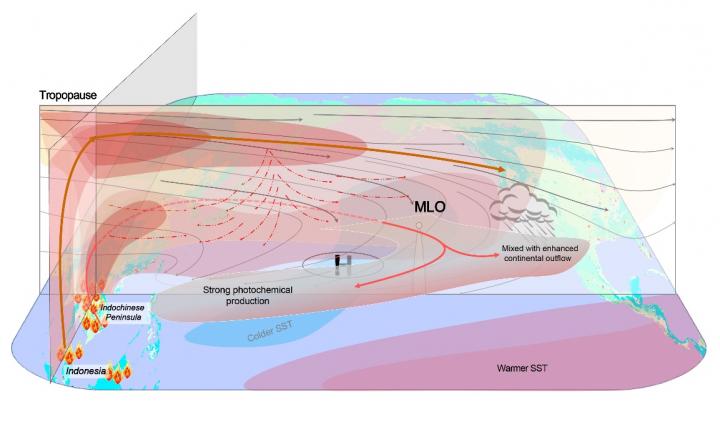
IMAGE: Conceptual schematic of the trans-Pacific O3 enhancement induced by ENSO and ENSO-mediated vegetation fires in Southeast Asia in spring. The vertical cross-section shows the O3 plumes and wind flows (grey…
view more
Credit: ©Science China Press
Long-range transboundary transport of air pollutants (e.g. ozone) is one of the important environmental concerns globally. Previous studies on trans-Pacific transport of air pollutants have been mainly focused on the influence of anthropogenic fossil fuel combustion sources in Asia, especially from China. This study reveals that the El Niño-Southern Oscillation (ENSO)-modulated vegetation fires in Southeast Asia, rather than fossil fuel plumes from China, dominate the springtime trans-Pacific transport of ozone across the entire North Pacific Ocean.
Ozone, produced mainly from photochemical reaction, is one of main secondary pollutants in many countries. It also plays a key role in atmospheric chemistry and climate change because of its dominant roles on the atmospheric oxidizing capacity and cycling of reactive trace gases in the troposphere. Ozone can be transported on regional to intercontinental scales due to its lifetime of a few weeks in the free troposphere. Previous studies attributed the long-range transport of ozone and its precursors from Asia to anthropogenic fossil fuel combustion sources, particularly those from China.
This study detected strong anomaly of ozone and its precursors in El Niño and La Niña springs based on satellite retrievals and ground based measurements. During El Niño springs, the intensified fires from Southern Asia result in enhanced ozone plumes that stretch over 15,000 km, from the South China Sea northeastward to Southwestern North America and the Gulf of Mexico, in both the lower-middle and upper troposphere. The enhancement is also observed in the in-situ measurements at Mauna Loa Observatory (MLO) in Hawaii, the most famous Global Atmosphere Watch station with long continuous records of ambient baseline carbon dioxide and ozone.
The study further applied a global-scale numerical model to explore the mechanism and to quantify the impact based on a series of experiments. It shows that both the ENSO-induced anomalies in circulation and enhanced vegetation fire emissions in Southeast Asia make stronger contributions to the ozone and carbon monoxide anomalies stretching from subtropical Asia to North America in El Niño spring. However, the year-to-year difference in vegetation fire emissions modulated by ENSO makes a stronger contribution than the anomalies due to meteorological variability alone. The study also reveal completely different transport pathways of the enhanced fire emissions from Indochina Peninsula and Indonesia over the Pacific Ocean: via lower-mid troposphere and upper troposphere, respectively.
The study proves once more how complex the interactions in the climate system are. It highlights the importance of continuous measurements in the remote North Pacific Ocean for characterizing the impacts from both natural climate variability and human activity, and also suggests that better ENSO forecasting could improve modelling of continental-scale long-range transport of air pollutants.
###
See the article:
XUE L, DING A, COOPER O, HUANG X, WANG W, ZHOU D, WU Z, McClure-Begley A, PETROPAVLOVSKIKH I, ANDREAE M, 2020. ENSO and Southeast Asian biomass burning modulate subtropical trans-Pacific ozone transport. National Science Review, doi.org/10.1093/ nsr/nwaa132.
https:/
TDnews














